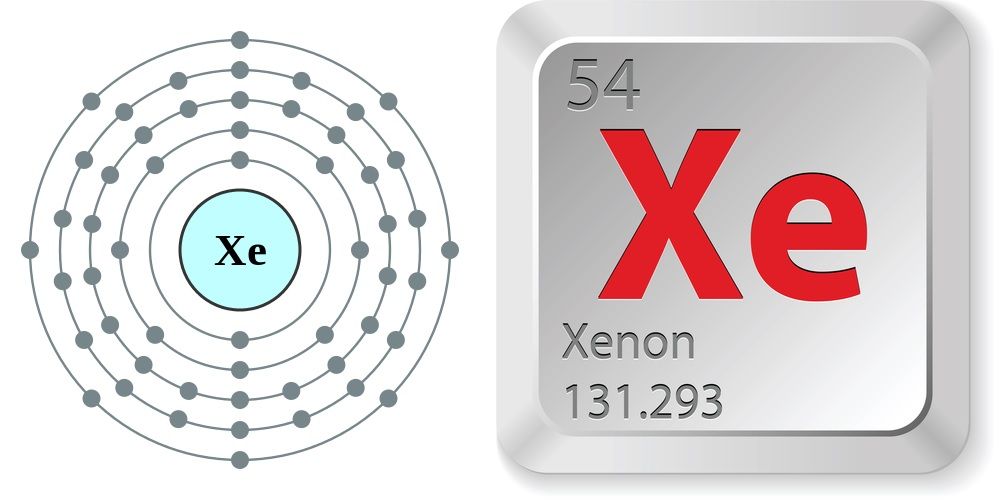Math Is Fun Forum
You are not logged in.
- Topics: Active | Unanswered
- Index
- » Science HQ
- » Xenon
Pages: 1
#1 2025-06-13 18:59:40
- Jai Ganesh
- Administrator

- Registered: 2005-06-28
- Posts: 52,723
Xenon
Xenon
Gist
Xenon (Xe) is a chemical element, a colorless, odorless, and rare noble gas with the atomic number 54. It's known for its inertness and unique properties, including its ability to form compounds under specific conditions. Xenon is found in trace amounts in Earth's atmosphere and is also present in gases emitted from some mineral springs.
Summary
Xenon is a chemical element; it has symbol Xe and atomic number 54. It is a dense, colorless, odorless noble gas found in Earth's atmosphere in trace amounts. Although generally unreactive, it can undergo a few chemical reactions such as the formation of xenon hexafluoroplatinate, the first noble gas compound to be synthesized.
Xenon is used in flash lamps and arc lamps, and as a general anesthetic. The first excimer laser design used a xenon dimer molecule (Xe2) as the lasing medium, and the earliest laser designs used xenon flash lamps as pumps. Xenon is also used to search for hypothetical weakly interacting massive particles and as a propellant for ion thrusters in spacecraft.
Naturally occurring xenon consists of seven stable isotopes and two long-lived radioactive isotopes. More than 40 unstable xenon isotopes undergo radioactive decay, and the isotope ratios of xenon are an important tool for studying the early history of the Solar System. Radioactive xenon-135 is produced by beta decay from iodine-135 (a product of nuclear fission), and is the most significant (and unwanted) neutron absorber in nuclear reactors.
Details
Xenon (Xe), chemical element, a heavy and extremely rare gas of Group 18 (noble gases) of the periodic table. It was the first noble gas found to form true chemical compounds. More than 4.5 times heavier than air, xenon is colorless, odorless, and tasteless. Solid xenon belongs to the face-centered cubic crystal system, which implies that its molecules, which consist of single atoms, behave as spheres packed together as closely as possible. The name xenon is derived from the Greek word xenos, “strange” or “foreign.”
Element Properties:
atomic number : 54
atomic weight : 131.29
melting point : −111.9 °C (−169.4 °F)
boiling point : −108.0 °C (−162.4 °F)
density (1 atm, 0 °C [32 °F]) : 5.887 g/liter (0.078 ounce/gallon)
oxidation states 0, +2, +4, +6, +8
Properties of the element
Xenon occurs in slight traces in gases within Earth and is present to an extent of about 0.0000086 percent, or about 1 part in 10 million by volume of dry air. Like several other noble gases, xenon is present in meteorites. Xenon is manufactured on a small scale by the fractional distillation of liquid air. It is the least volatile (boiling point, −108.0 °C [−162.4 °F]) of the noble gases obtainable from the air. The British chemists Sir William Ramsay and Morris W. Travers isolated the element in 1898 by repeated fractional distillation of the noble gas krypton, which they had discovered six weeks previously.
The element xenon is used in lamps that produce extremely short and intense flashes of light, such as stroboscopes and lights for high-speed photography. When a charge of electricity is passed through the gas at low pressure, it emits a flash of bluish-white light; at higher pressures, white light resembling daylight is emitted. Xenon flashlamps are used to activate ruby lasers.
Natural xenon is a mixture of nine stable isotopes in the following percentages: xenon-124 (0.096), xenon-126 (0.090), xenon-128 (1.92), xenon-129 (26.44), xenon-130 (4.08), xenon-131 (21.18), xenon-132 (26.89), xenon-134 (10.44), and xenon-136 (8.87). The mass numbers of the known isotopes of xenon range from 118 to 144. The xenon found in some stony meteorites shows a large proportion of xenon-129, believed to be a product of radioactive decay of iodine-129, whose half-life is 17,000,000 years. Measuring the xenon-129 content of meteorites casts light on the history of the solar system. More than a dozen radioactive xenon isotopes produced by fission of uranium and other nuclear reactions are known. For example, xenon-135 (9.2-hour half-life) is produced by uranium fission in nuclear reactors, where it is troublesome because it absorbs fission-producing neutrons. Xenon-129 is of particular importance because this isotope can be observed by nuclear magnetic resonance spectroscopy, which makes it useful for the structural characterization of xenon compounds. The xenon isotopes produced in the greatest amount by nuclear fission are xenon-131, -132, -134, and -136, which are stable, and xenon-133, which is radioactive, with a half-life of 5.27 days.

It appears to me that if one wants to make progress in mathematics, one should study the masters and not the pupils. - Niels Henrik Abel.
Nothing is better than reading and gaining more and more knowledge - Stephen William Hawking.
Offline
Pages: 1
- Index
- » Science HQ
- » Xenon